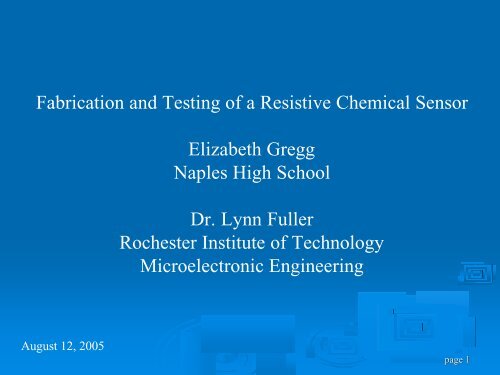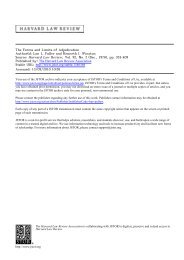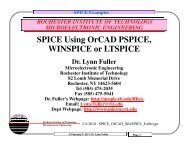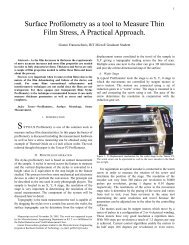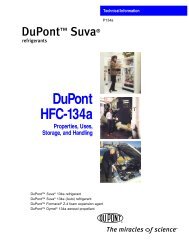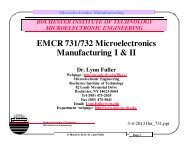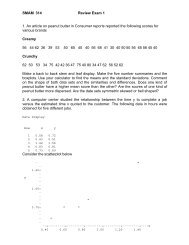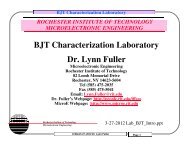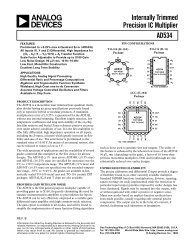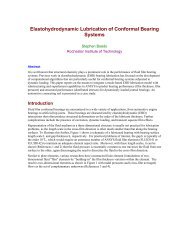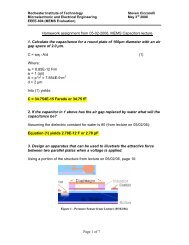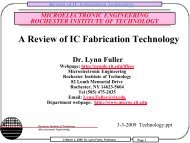Chem Sensor Lab - People - Rochester Institute of Technology
Chem Sensor Lab - People - Rochester Institute of Technology
Chem Sensor Lab - People - Rochester Institute of Technology
You also want an ePaper? Increase the reach of your titles
YUMPU automatically turns print PDFs into web optimized ePapers that Google loves.
Fabrication and Testing <strong>of</strong> a Resistive <strong>Chem</strong>ical <strong>Sensor</strong><br />
Elizabeth Gregg<br />
Naples High School<br />
Dr. Lynn Fuller<br />
<strong>Rochester</strong> <strong>Institute</strong> <strong>of</strong> <strong>Technology</strong><br />
Microelectronic Engineering<br />
August 12, 2005<br />
page 1
Abstract<br />
FABRICATION AND TESTING OF A RESISTIVE CHEMICAL SENSOR<br />
Elizabeth Gregg and Dr. Lynn Fuller, Department <strong>of</strong> microelectronic Engineering.<br />
egregg@naples.k12.ny.us<br />
A chemical sensor was designed, fabricated, and tested as part <strong>of</strong> a Science<br />
Research Program between Naples High School and Microelectronic Engineering at<br />
<strong>Rochester</strong> <strong>Institute</strong> <strong>of</strong> <strong>Technology</strong>. The chemical sensor consisted <strong>of</strong> a polymer<br />
carbon film in contact with interdigitated gold electrodes. The electrical resistance is<br />
measured using an ohmmeter. Sensed chemical vapors cause the polymer to swell<br />
and results in an increase in electrical resistance. The sensor response as a<br />
function <strong>of</strong> time was measured while presenting various amounts and types <strong>of</strong><br />
chemical vapors. The sensors response and recovery time where found to be a<br />
function <strong>of</strong> the type <strong>of</strong> chemical and its concentration.<br />
page 2
Outline<br />
‣ Introduction<br />
‣ Design<br />
‣ Fabrication Sequence<br />
‣ Testing<br />
‣ Results<br />
‣ Conclusions<br />
‣ Acknowledgements<br />
‣ References<br />
page 3
Introduction<br />
<strong>Chem</strong>ical sensors can be very specific like the carbon monoxide<br />
sensors for home use or less specific like the human nose.<br />
<strong>Sensor</strong>s that are very specific require simple evaluation techniques<br />
such as the measurement <strong>of</strong> sensor electrical resistance. The less<br />
specific sensors require more complex evaluation techniques such<br />
as neural networks and artificial intelligence and usually an array<br />
<strong>of</strong> different sensors. The type <strong>of</strong> sensor described in this<br />
presentation could be <strong>of</strong> either type described above depending on<br />
the type <strong>of</strong> polymer used on the electrode array.<br />
page 4
The objective is to design an<br />
electrode that could be<br />
combined with a conductive<br />
polymer that is sensitive to a<br />
single chemical or a variety<br />
<strong>of</strong> chemicals.<br />
Top view<br />
Design<br />
Computer Aided Design (CAD)<br />
Polymer<br />
Gold<br />
<strong>Sensor</strong><br />
page 5
Maskmaking<br />
The design file is sent to the MEBES<br />
electron beam mask writing machine<br />
creating the pattern in chrome on glass at<br />
5X the actual size.<br />
page 6
Fabrication Sequence<br />
1. RCA Clean Wafers<br />
2. Grow 5,000 Å oxide<br />
3. Evaporated Chrome and Gold<br />
4. Photolithography for Electrode<br />
Pattern<br />
5. Wet Etch Gold<br />
6. Wet Etch Chrome<br />
7. Strip Photoresist<br />
8. Coat with Photoresist to Protect<br />
During Sawing<br />
9. Saw Wafers<br />
10. Clean Wafers<br />
11. Attach Clips<br />
12. Apply Polymer<br />
13. Test <strong>Sensor</strong><br />
Gold<br />
Chrome<br />
Insulator<br />
Silicon<br />
Gold<br />
Chrome<br />
The sensor consists <strong>of</strong> three<br />
layers on silicon substrate<br />
1000Å<br />
300Å<br />
5000Å<br />
page 7
Fabrication Details<br />
Grow Oxide using<br />
Bruce Furnace Tube 1<br />
1000 °C for 100 min<br />
gives 0.5 micrometers<br />
(5000 Å) oxide<br />
RCA Clean<br />
page 8
Fabrication Cont…<br />
Evaporation <strong>of</strong> Chrome and Gold metals<br />
using the CHA Evaporator (right)<br />
Tungsten Wire Coated With Chrome<br />
Moly Boat for Heating Gold<br />
page 9
Fabrication Cont…<br />
Photolithogrophy for metal pattern<br />
using Canon Stepper (bottom)<br />
5X Mask<br />
page 10
Fabrication Cont…<br />
Etch gold<br />
Etch chrome<br />
Strip photo resist<br />
page 11
Fabrication Cont…<br />
Saw Wafers using Wafer Saw<br />
Add Chip Pins (below)<br />
K&S 780 Wafer Saw<br />
page 12
Completed Electrodes<br />
Upper Left: Finished <strong>Sensor</strong> with chip pins<br />
Upper Right: Close up <strong>of</strong> interdigitated gold fingers<br />
page 13
Completed <strong>Sensor</strong><br />
Mix a polymer with Carbon Black and<br />
apply a thin coat over interdigitated gold<br />
fingers<br />
page 14
The resistance is measured<br />
using and ohmmeter<br />
Measurements are taken every<br />
15 seconds<br />
<strong>Chem</strong>ical fumes are presented<br />
to the sensor<br />
Manual Testing<br />
Micro <strong>Sensor</strong> Resistence (ohms)<br />
500<br />
450<br />
400<br />
350<br />
Resistence<br />
300<br />
250<br />
200<br />
150<br />
100<br />
50<br />
0<br />
1 2 3 4 5 6 7 8 9 10 11 12 13 14 15 16 17 18 19 20 21 22 23 24 25<br />
Time<br />
page 15
Automated Testing<br />
Computer controlled ohmmeter<br />
measures resistance every<br />
second for 3 min.<br />
Output is plotted versus time.<br />
30s <strong>of</strong>f, 30s on, 60s <strong>of</strong>f, 30s on, 30s <strong>of</strong>f<br />
page 16
Results<br />
30s <strong>of</strong>f, 30s on, 60s <strong>of</strong>f, 30s on, 30s <strong>of</strong>f<br />
0.5 ml Acetone/ 125 ml bottle = 4000 ppm<br />
Resistance goes from ~100 ohms (no vapor)<br />
to ~ 100,000 ohms (with vapor)<br />
30s <strong>of</strong>f, 30s on, 60s <strong>of</strong>f, 30s on, 30s <strong>of</strong>f<br />
Isopropanol ~ 10,000 ppm<br />
No Response<br />
page 17
Results<br />
30s <strong>of</strong>f, 120s on, 60s <strong>of</strong>f, 120s on, 30s <strong>of</strong>f<br />
0.1 ml Acetone/ 125 ml bottle = 800 ppm<br />
Resistance goes from ~100 ohms (no<br />
vapor) to ~ 4,000 ohms (with vapor)<br />
<strong>Sensor</strong> shows no response to 1 ppm<br />
acetone (just measurement noise)<br />
page 18
Conclusions<br />
‣ The sensor responded to acetone vapor<br />
‣ The sensor does not respond to<br />
Isopropanol<br />
‣ The response is proportional to vapor<br />
concentration<br />
‣ The recovery time was longer than the<br />
response time.<br />
‣ <strong>Sensor</strong> does not respond to 1 part per<br />
million (ppm)<br />
page 19
Future Work<br />
‣ Testing with different polymers.<br />
‣ I have designed another sensor that<br />
includes a heater that will help decrease<br />
the recovery time.<br />
‣ See how a given sensor responds to an<br />
variety <strong>of</strong> different chemical vapors and<br />
concentrations.<br />
page 20
Acknowledgements<br />
‣ Dr. Fuller<br />
‣ Gianni Franceschinis<br />
page 21
References<br />
‣ 1. “MEMS CHEMICAL GAS SENSOR (NOSE),” Frank<br />
Zee and Jack Judy Electrical Engineering Department<br />
University <strong>of</strong> California Los Angeles, Los Angeles, CA<br />
90095 zee@ee.ucla.edu, jjudy@ucla.edu<br />
‣ 2. EMCR870 Microelectromechanical Systems Class<br />
Notes, Dr. Lynn Fuller<br />
page 22
Thank You!<br />
page 23


